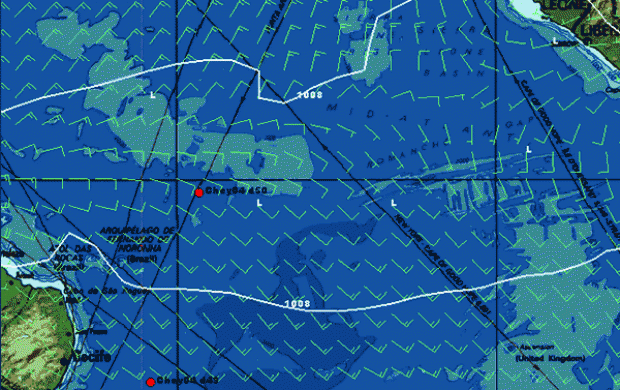Across the Equator
Sunday March 28th 2004, Author: James Boyd, Location: Transoceanic
Day 50
Position at 0510GMT: 00deg 41.000S 28 56.000W
This morning at 0813 Steve Fossett and the crew of Cheyenne crossed the Equator at 28deg 38W. In the process they picked up another record from Ushant round the world and back to the Equator with a time of 50 days 3 hours and 3 minutes. In comparison Orange didn't cross the Equator until her 54th day at sea and this was a similar time for Geronimo last year.
After their slow passage past Rio last week, the crew of Cheyenne are breathing a sigh of relief that they are now back on track and fully up to speed once again. Their 24 hour run up until 0510 this morning was 544 miles, while yesterday it was an equally useful 519. It seems incredible that less than a decade ago a run of 544 miles would have been the fastest a boat had ever sailed in a day. Today, of course, with the advent of the G Class maxi-multihulls the record now stands at a smidgeon under 700 miles.
Measuring Cheyenne's relative position against Orange's 2002 record is hard at the moment because of Orange's very different course up the South Atlantic, we estimate it to be around 1,600 miles. So since the middle of last week Fossett and his crew have regained 650+ miles over the record, putting them 3-4 days ahead.
Although on board data was not available for the 0510GMT report, earlier reports in the night showed Cheyenne to be making between 18 and 24 knots on a course of 031deg in 15-18 knots of southeasterly breeze.
Unusually (as Brian Thompson confirms below) the Doldrums seem to be a long way south, hovering just north of the Equator and we can expect Cheyenne to have a slower day today before she breaks into the northeasterly trades at around 4degN.
Weather radar image (below) showing light winds ahead for Cheyenne

 Brian Thompson
reports from on board
Brian Thompson
reports from on board
Roaring along in the trades tonight, the moon has set and the stars are guiding our way north. Occasional squalls move through but they are not too strong yet. It’s another 350 miles to the doldrums, which we will reach this coming night. The wind is up and down in velocity, so we have made a few sail changes. We started with full main and solent, went to one reef and staysail, then to one reef and solent and now back to one reef and
staysail again.
With the loss of the furler on the solent the changes take a little longer than usual on this boat, but are similar to the changes we have to do on the Ollier cats, so we have a good technique. There is less windage and weight aloft without the furler, so we will be gaining speed between the changes. The only concern is the size of the webbing hanks on the solent. They were designed more for emergency use rather than for sailing 3/4 of the way around the world...
Justin [Slattery] went up the rig for a check earlier today and all looked good. He may have another chance in the doldrums, but after that we will be beating in the NE trades and will not want to bear the boat away for a rig check. The motion on this boat up the rig is much worse than on a monohull so ideally the conditions have to be better than usual to go up, although it is not always possible to wait for them.
We are now past Salvador in Brazil and heading along the coast, we will pass abeam of Recife in about 3 hours. These are familiar waters for me after doing the Mini Transat in 2001 and the Transat Jacques Vabre in 2003, both of which finish in Salvador. When you finish those races you are given huge platter of fresh fruit; papaya, water melon, pineapple, etc. It would taste really good this morning! To make up for it Damian [Foxall] has made up a blend of freeze-dried strawberries and soaked muesli with powdered milk.
I was looking back at our times for the various landmarks around the world and noticed a certain pattern. We did the start to Cape of Good Hope in just under 20 days, to New Zealand in just under 30, to Cape Horn in just under 40 days. It was looking like we could do the Equator in fewer than 50, but with the days spent drifting past Rio, we are looking to be just over that.
Our time for this section from the Horn to the Equator should still be just the fastest, slightly better than Orange but not quite as good as we had hoped. The South Atlantic really is the trickiest section of the RTW route, both going north or south, but particularly north. We will have been slowed 5 times in total; briefly in the lee of Cape Horn and again behind the Falklands, then light air beating north of the Falklands, then again off Rio, and soon the Doldrums which are, unusually, in the South Atlantic at
present.
Hopefully the North Atlantic will be more straightforward and we manage to keep moving the whole way. We are certainly going to have to take a longer than rhumb line route but that is always to be expected. Getting caught in the Azores High will be the trapdoor we need to avoid. This is what put paid to Geronimo’s chances of the record last year.
Anyway, there are a lot of miles to be sailed before then (3700 to the finish). I’m off on watch now and aim to make 100 miles in the next four hours. As Moose says, that will be 100 miles we won't have to do again.
Brian









Latest Comments
Add a comment - Members log in